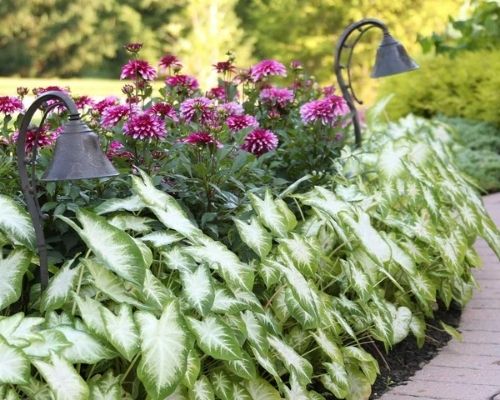Enhance Your Garden With Burgundy Flowers and Foliage
Burgundy is a great color to have in your garden design tool kit. From garnet to merlot, maroon to mahogany, these dark red hues can take your garden to a whole new level! Here are some creative ways to put burgundy flowers and foliage to work in your yard and garden.
Create Accents and Focal Points
In a landscape that’s dominated by shades of green, burgundy is an unexpected color that always attracts the eye. It’s also a solemn hue with a refined manner. Together, these characteristics give burgundy a gravitas that can be put to great use in a garden.
Burgundy flowers and foliage are difficult to ignore, so it takes no effort to make them focal points. Weaving splashes of these darker tones through a garden will establish a sense of rhythm and guide the eye from one area to the next.

Add Depth and Layers
Like other dark colors, burgundy flowers and foliage tend to recede, while brighter colors come forward. This means you can use these dark tones to add depth and mystery, and make small spaces seem larger. Burgundy foliage reads like a shadow and accentuates the shape and volume of neighboring plants.
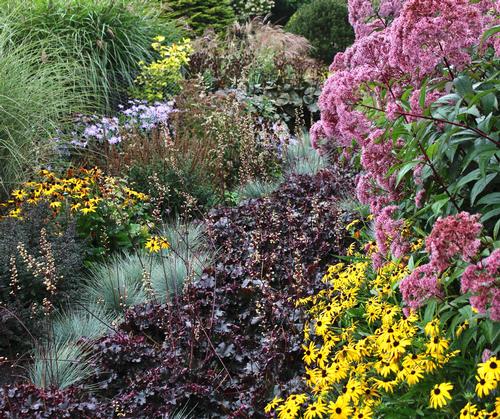
Cultivate a Range of Moods
The hushed tones of burgundy have a calming effect and add a feeling of serenity to a garden. Yet moody, purple-red hues can also create drama and excitement. Pairing burgundy with gold or lime, makes these bright colors look even more vibrant. Conversely, the sophisticated base notes of black currant and plum, make pale blue, pink, grey and creamy yellow look even softer.
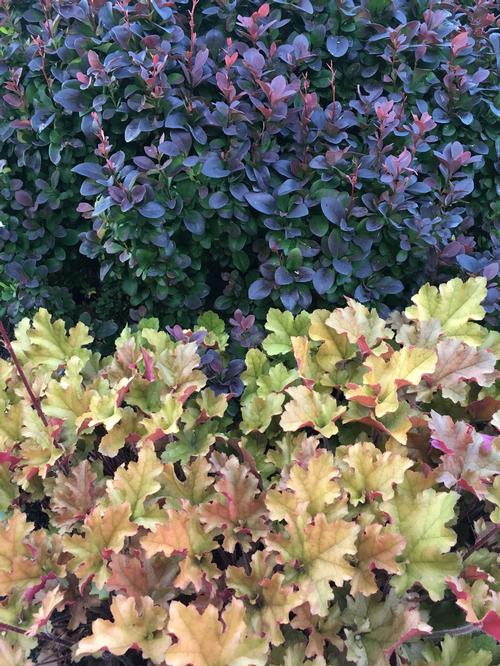
Leverage the Light
Don’t hide burgundy flowers in the shadows. Dark-colored foliage absorbs the light and can be difficult to see in the shade. A sunny spot is usually more effective. You’ll also find that in most cases, sunlight intensifies deep pigments, so most plants are at their darkest when grown in full sun. Glossy petals or shiny leaves also take on a silvery sheen in the sun, which adds yet another layer of visual interest.
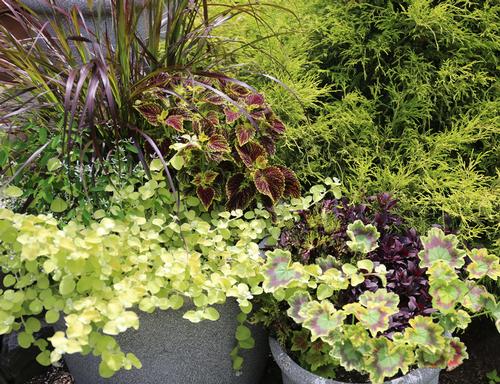
Create Color Echoes
Burgundy flowers and foliage can be used to compose exquisite vignettes that are as pleasing as any work of art. Connecting two plants with a common hue will give you a “color echo” that highlights each partner’s special beauty and also delivers a new and satisfying color harmony.

There's no end of pairing possibilities. Plant a plum-colored hellebore with Epimedium versicolor (as shown at left). Combining tulips ‘Ronaldo’ with ‘Princess Irene’ will bring out the latter’s plum-colored flares. The wine-red brushstrokes on Asiatic Lily ‘Patricia’s Pride’ look even more dramatic when they’re blooming beside a dark-leaved Heuchera.
One of the best places to play with color echoes is in pots and planters. Some of the many candidates for container planting include the velvety coleus ‘Dark Star’, pearl millet ‘Purple Majesty’, Alternathera ‘Red Threads’ and elephant ears ‘Diamond Head’.
See below for a list of sixty plants with burgundy flowers and foliage.
You can also learn more about using color here: How to Use Orange in Your Flower Garden, How to Use Pink in Your Flower Garden and 6 Tips for a More Colorful Flower Garden.
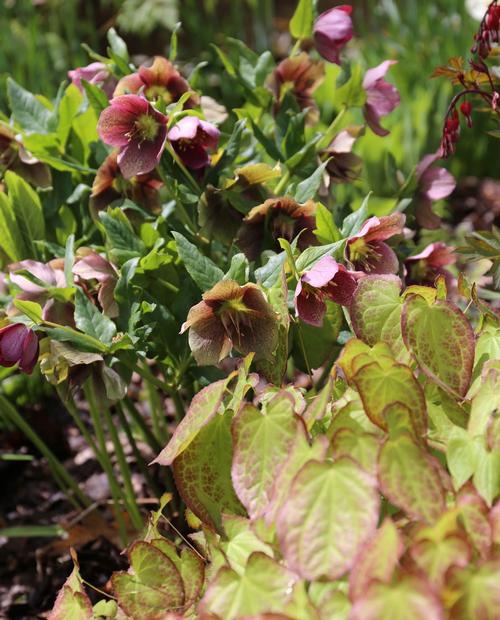
Annuals and Tender Perennials with Burgundy Flowers or Foliage
- Aeonium ‘Zwartkop’ (succulent)
- Alternathera ‘Red Threads’, ‘Purple Knight’
- Amaranthus ‘Red Spike’, ‘Oeschberg’
- Anemone DeCaen ‘Bordeaux’
- Bronze fennel
- Canna ‘Tropicanna Black’, ‘Australia’
- Coleus ‘Dark Star’, ‘Garnet Robe’
- Colocasia ‘Diamond Head’ (elephant ears)
- Cordyline ‘Purple Tower’, ‘Festival Burgundy’
- Cosmos atrosanguineus (chocolate cosmos)
- Dahlia ‘Arabian Night’, Karma Choc, Nuit d’Ete, Rip City, Jowey Mirella, Tartan, Contraste
- Ensete ventricosum (Abyssinium banana)
- Eucomis ‘Sparkling Burgundy’ (pineapple lily)
- Gladiolus ‘Espresso’
- Hibiscus ‘Kopper King’
- Ipomoea ‘Blackie’ (sweet potato vine)
- Oxalis triangularis (false shamrock)
- Papaver somniferum ‘Dark Plum’, ‘Black Beauty’
- Pennesetum setaceum rubrum (purple fountain grass)
- Pennisetum glaucum ‘Purple Majesty’ (pearl millet)
- Perilla frutescens
- Petunia ‘Zinfandel’, Burgundy Velour’
- Phormium ‘Evening Glow’, ‘Guardsman’ (New Zealand flax)
- Purple basil ‘Dark Opal’, ‘Red Rubin’
- Purple sage
- Snapdragon ‘Black Prince’
- Tulip ‘Queen of Night’, ‘Black Parrot’, ‘Havran’, ‘Ronaldo’, ‘Merlot
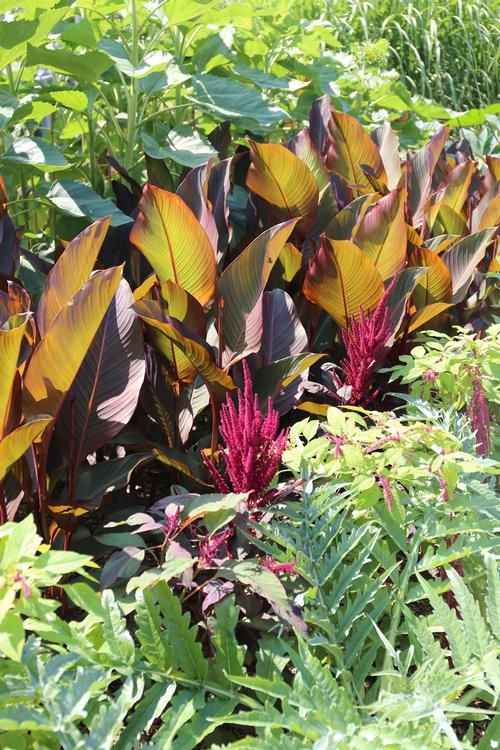
Perennials and Biennials with Burgundy Flowers or Foliage
- Actaea or Cimicifuga (baneberry, black cohosh, snakeroot)
- Ajuga (bugleweed)
- Alcea ‘Double Purple’ (hollyhock)
- Allium atropurpureum
- Allium sphaerocephalon (drumstick allium)
- Aquilegia ‘Black Barlow’ (columbine)
- Asiatic Lily ‘Mapira’, ‘Patricia’s Pride’
- Clematis ‘Niobe’
- Daylily ‘Bela Lugosi’, ‘Siloam Royal Prince’, ‘Rainbow Warrior’
- Dianthus barbatus ‘Sooty’, Black Adder’ (sweet William)
- Euphorbia ‘Rubra’, ‘Ruby Glow’
- Fritillaria meleagris (snake’s head fritillary)
- Geranium phaeum ‘Samobor’
- Geranium pretense ‘Dark Reiter’
- Hellebore
- Heuchera ‘Midnight Burgundy’, ‘Plum Pudding’, ‘Obsidian’
- Iris (bearded, Siberian, Dutch)
- Ophiopogon ‘Nigrescens’ (Black mondo grass)
- Penstemon ‘Huskers Red’
- Peony ‘Black Beauty’, ‘Buckeye Belle’
- Sanguisorba tenuifolia purpurea (burnet)
- Sedum ‘Vera Jameson’, ‘Ruby Glow’

Shrubs and Trees with Burgundy Flowers or Foliage
- Acer palmatum ‘Red Dragon’, ‘Bloodgood’ (Japanese maple)
- Berberis ‘Concorde’, ‘Crimson Pygmy’, Royal Burgundy’ (non-invasive barberry)
- Cercis canadensis ‘Forest Pansy’ (redbud)
- Cotinus coggygria (smoke bush)
- Physocarpus ‘Summer Wine’ (Ninebark)
- Prunus virginiana ‘Schubert’ (Purple chokecherry)
- Prunus x cisterna (purple-leaf sand cherry)
- Rosa ‘Burgundy Iceberg’, ‘Munstead Wood’
- Sambucus nigra ‘Black Beauty’, ‘Black Lace’ (elderberry)
- Vitis vinifera ‘Purpurea’ (purpleleaf grape)
- Weigela ‘Dark Horse’, ‘Wine and Roses’

